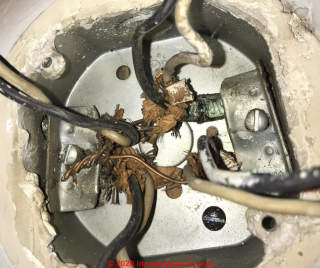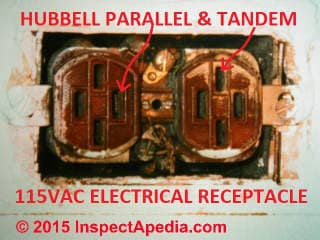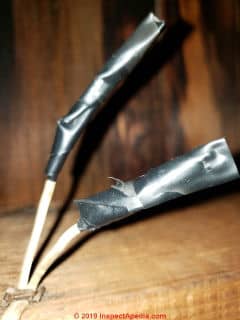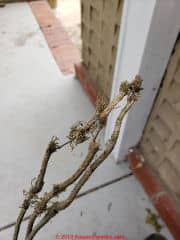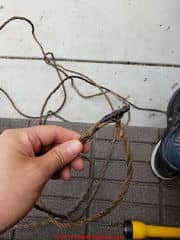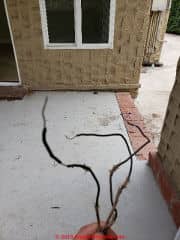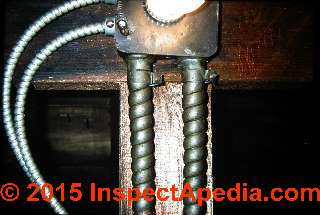 Old House System FAQs
Old House System FAQs
Q&A on old Electrical Service, Panel, Devices, Grounding, Knob & Tube & other Old Wiring
- POST a QUESTION or COMMENT about old house wiring, knob & tube, old fuse panels, old house wiring condition & safety
Q&A on how to inspect & repair old house or old building electrical wiring.
This article series answers basic questions about assessing and repairing the electrical service, capacity, wiring type, condition, and safety in older homes.
InspectAPedia tolerates no conflicts of interest. We have no relationship with advertisers, products, or services discussed at this website.
- Daniel Friedman, Publisher/Editor/Author - See WHO ARE WE?
Old House / Building Electrical Wiring Q&A
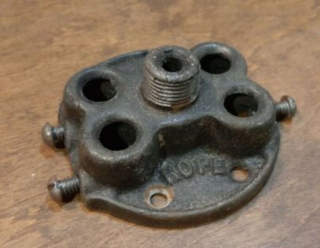 These questions and answers were posted originally
These questions and answers were posted originally
at OLD HOUSE ELECTRICAL SYSTEMS - be sure to review the information there.
[Click to enlarge any image]
On 2020-03-20 - by (mod) -
Mark
Thank you for the helpful questions about the history of types of electrical wire used in residential buildings. Here is a nano-history of types of electrical wire use:
The shift to popular use of plastic-insulated NMC or "non-metallic-cable" electrical wire in residential and light commercial use began in the late 1950's in North America, but you will not find any date or year in which cloth- or fabric-insulated electrical wire use ceased completely.
In fact some fabric-insulated electrical wire use continues into the present day.
Your question about dating the use of ground wiring in electrical circuits has a similar answer.
Pure un-grounded knob and tube circuit wiring began in North America around 1890, waned in popularity by the 1950s but continues to be legal in many jurisdictions even today in 2020.
Metallic-sheathed "BX" electrical wire entered popular use in North America as early as 1920 and was widely-used in the 1940s and in some jurisdictions is required for new wiring even today in 2020.
Non-Metallic (NMC) electrical wiring was used in North America beginning in the 1930s first as fabric or fabric-and-rubber insulated wire and later - by 1965 - was commonly installed as plastic-insulated wire. Plastic NMC pretty much replaced fabric NMC in branch circuit wiring by 1975, and it continues in use today. Some early NMC wire did not contain an electrical ground.
Metal conduit-wired electrical circuits were used in North America as early as 1940 and continue to the present.
And all of these answers depend on and vary among the country and city where the building is located.
On 2020-03-20 by Mark
When did they stop using cloth for insulation
What year did they add ground wire to residential wiring
On 2020-02-14 - by (mod) -
Thanks for the note, Mario. Indeed porcelain knobs or "cleats" were used to hold knob-and-tube electrical wire off of wood surfaces.
On 2020-02-14 by Mario Di russo
That open wiring usually has porcelin cleats holding it in place on the wall.in older homes built in late 1800 Charlestown and Boston Ma. Area !
On 2020-01-13 - by (mod) -
Richard: apologies but no, I can't say for sure what those wires are; an electrician would tell us immediately by use of a VOM or DMM to determine the hot, neutral and ground.
Color code conventions would say
Green - ground
Black - hot or line voltage
Red - an alternative hot or line voltage
but more likely if your building is using 120VAC wiring one of those, perhaps the red, is acting as the neutral.
On 2020-01-13 by richard milnes
in my ceiling rose wiring I have a cable with one black & one green wires in it and one cable with one red wire in it, could you tell me what these are for please.
On 2020-01-10 2 - by (mod) - Plugged in appliance into outlet, outlet sparked and blew fuse.
OK first let's not kill you nor burn down the house. You're competent on electrical wiring, right? Else leave it alone.
Safest would be to leave the circuit OFF entirely until it's de-bugged and repaired.
I suspect that a loose wire shorted in the receptacle and then burned itself or its connector to smithereens, but that's just a guess from my desk here in central Mexico (over the wall and hoping to help).
What did you find when you replaced the outlet? Photos?
If it appeared intact yet you saw sparks there, it's possible that the burn-up was at another connection upstream in the circuit.
On 2020-01-10 by rapidduct
Plugged in appliance into outlet, outlet sparked and blew fuse. Replaced fuse still no power, replaced outlet and fuse still now power. HELP
On 2019-12-18 - by (mod) - How can I reattach the porcelain that was accidentally knocked off
Steve,
Sure you can reconnect knob and tube wires that were accidentally cut.
Back in the day when that wiring was new the electrician would have simply splice in a short length of additional wire sufficient to make the reconnection and she would have tipped joint thoroughly with electrical tape.
However in modern practice any such place would be enclosed in a metal or plastic electrical box.
I wouldn't consider that a modification or extension of a knob and tube circuit and I would expect your local electrical inspector to approve such a repair.
On 2019-12-1 by Steve Houze
How can I reattach the porcelain that was accidentally knocked off putting up drop ceiling tiles, the wire is cut in half
M
On 2019-10-19 - by (mod) - old fuse panel identification
Try attaching photos of the panel and breakers
On 2019-10-18 by Gerry
Question
I have an old fuse panel and the only numbers I can find to identify it are 200 4240. Anyone know whether this panel has had any issues. It seems to be working fine.
On 2019-08-05 - by (mod) - figuring out which wires are hot and which are neutral
If you know how to use a voltmeter or digital multimeter and how to work on electrical wiring safely you can test to see which is the hot wire.
Watch out: if you don't know how to do that work safely you could be shocked or killed.
Sometimes there are other Clues available to identify which was a hot and which was a neutral wire such as noting the color of the screws to which wire's at the junction box or fiction were connected.
- Neutral wires will be connected to the silver screw and
- the hot wire would be connected to the Brass colored screw.
On 2019-08-04 by Mark
Can't tell hot wire from cold. Cloth insulation.want to wire electric box
On 2019-04-14 - by (mod) -
Glad we could assist - we also welcome questions, criticism, and content suggestions.
On 2019-04-14 1 by Anonymous
this page helped me with a small project I was doing thanks (mostly just the pictures)
IMAGE LOST by older version of Clark Van Oyen’s useful Comments code - now fixed. Please re-post the image if you can. Sorry. Mod.
On 2019-03-03 - by (mod) - Testing from hot wire to ground you should be seeing 120V not 55 or 60V -
Dean
Testing from wire to ground you should be seeing 120V not 55 or 60V - sounds like there's a short.
The hot wire to ground would show 120V or close to it
The neutral wire would show nothing if there were no short.
On 2019-03-01 by Dean
I just started working on old home wiring, 1910ish. can not tell which one is common or hot. Both have identical wrap. When u test them separately u get 55,60 volts each? I can find the hot one with a tracer, but connecting to another receptacle to provide power i cant tell between hot and common. Or is it just hot with ground? This is in Rochester, NY
On 2018-09-15 - by (mod) -
Jean
what you describe sounds dangerous, with the risk of both fire and shock.
It's not something that I can diagnose from just your brief a text.
To be safe you should turn the circuit off. Electrician would doubtless trace a hot and neutral lines looking for a short between them or within or inside of a connected device.
On 2018-09-11 by JeanO
Older house built in the 20s found a lot of knob and tube being fed from Romex... plugged in a vacuum cleaner ran for a bit lights flickered circuit went out did not trip a breaker went up in the attic to see if there were any issues with animal chews or whatever and found that the neutral is also carrying 120 volts
and unlike some knob and tube I've seen the hot is being switched but again did not trip a breaker ....curious as to where to look I've already eliminated all the ceiling fans and anything plugged into that circuit and all of the constant hot wall sconces
On 2019-12-05 - by (mod) - figuring out 1960 house wiring
Patty:
I see fabric exterior sheathing on plastic covered electrical wired: black is normally "hot" and white is normally "neutral" but one pair of wires could have been used to wire up a switch to turn the fan on and off;
Watch out: if you are not familiar with proper electrical wiring you ought not fool with these wires - you could be shocked or killed or start a house-fire.
An electrician would use a DMM or VOM (multimeter) to identify which wires are hot, neutral, and intended for a switch, or that are being used to power other devices "downstream" from this over-crowded junction box.
As an aside I see the metal box isn't properly connected to the electrical ground wires and the ground wires themselves are simply twisted together - no connector was used: not a safe, reliable practice (though it's common).
On 2019-12-05 by Patty
I removed a ceiling fan to hang a new one I purchased and found a confusing array of black and white wires coming from the same point in four places. They have some brown paper that I believe originally wrapped the two together.
My house was built in 1960 but I cannot figure out what each set of black and white wire is neutral, ground and hot. Please advise. Picture attached
On 2019-10-27 - by (mod) - does metallic sheathing make aluminum (or copper) wire safe?
Catherine
IF the wire insulation or sheathing is in good condition on an electrical wire it's doing its job: preventing a short circuit between conductors or between conductors and other building components like pipes.
But insulation alone does not make a wiring system "safe" as there are plenty of other snafus that could be present.
And no type of insulation or sheathing makes ALUMINUM branch circuit wiring "safe" - see details at
ALUMINUM WIRING HAZARDS & REPAIRS
On 2019-10-27 by Catherine
Does non metalic sheathing make a conductor of copper and aluminum safe?
On 2019-06-21 - by (mod) -
Pauly
at ELECTRICAL RECEPTACLE TYPES
you'll see a photo of and discussion of the receptacle that I think is yours in your photo.
On 2019-06-21 by Pauly - What is this thing?
My house was built in 1918, I have a couple of receptacles that I would love to replace (maybe using wire mold boxes and GFCI receptacles. When checking the prong holes I get hot on two, low voltage on one (probably the neutral) and nothing on the fourth. What is this thing?
On 2019-06-17 - by (mod) - insulation on old wiring: what is it's age
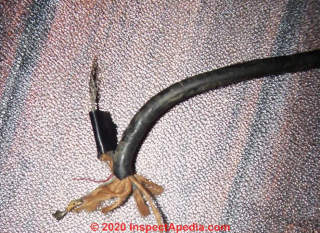 Thanks for the photo and question, Darrell.
Thanks for the photo and question, Darrell.
Wiring such as shown in the line cord in your photo was widely used in North America as early as the 1940s and continues to the present.
In trying to date a tool it's always helpful to include details such as
- a photo of the tool and of each of the data tags or nameplates whose data is always critical
- the country and city where the tool was found or used
- any records of repairs or modifications to the tool (that can include line cord replacement)
On 2019-06-17 by darrell
I inherited 2 old shop tools from my dad, They are craftsman with capacitor start motors. both units have strangely silver wire. Doubting that my dad had that kind of money back in 1960 or so, they both probably were purchased used.
The other indication that these machines are very old is that the outer insulating cover is black, probably rubber based, while the black and white inner insulation is still quite good. Any guess as to the span of years this was used?
Question: safety of exposed ends of "abandoned" or "dead" electrical wires
Hi I'm a new homeowner needing some advice. I Found old wiring in my crawlspace. Looked cloth wire with ends tattered but the middle spliced to copper ?lamp wiring that leads to house. Third pic was the middle that was spliced. I'm assuming it's all dead since both ends were laying on the crawlspace floor.
I pulled off the tattered wire from the copper lamp wiring but couldn't not yank the copper wiring out of the floor of the house. I covered the end with electrical tape.
Theres no way the wire can be live right? The ends of the tattered aluminum wires it was spiced with were just laying there. The rest of the house is wired pretty well with yellow updated Romex to a 200 panel. Thank you!
Reply: never say "there's no way the wires can be live" before you've traced the entire circuit
Watch out: It's best to err on the side of caution when we don't know the status of old, supposedly-dead electrical wires.
I certainly wouldn't assume that old wiring is not live. I have often found supposedly dead wires that have been connected to power.
A concern is that even if wires are disconnected at both ends of their original installation, unless the wire ends are properly-treated, someone might, in the future, erroneously connect the wires at one end, making the other wire end dangerous.
That's a good way to set the building on fire or to electrocute someone who touches them in the future.
Also the sort of electrical work that you described such as lamp-cord wiring is indicative of very inexperienced electrical work.
It's safest if all such wiring is removed, and if those lamp-cord wired circuits that are needed, you need to have them correctly installed by an electrician.
I agree that you don't always have to remove all dead wires but they need to be joined spliced and capped wherever those ends can be found and certainly lamp cord that runs through your building needs to be absolutely dead. Don't leave any of that live.
If "dead" or "abandoned" electrical wires must be left in place (as can be the case where the wires are fastened within an enclosed wall or ceiling, I like to cap the "dead" wire ends with a twist-on connector after joining them together.
That assures that if someone connects the other wire ends to a live circuit in the future they'll immediately trip a circuit breaker or blow a fuse - indicating that something's wrong - and unsafe.
Reader follow-up:
Thank you for your advice! Having the electrician take a look. ...
The wire was dead and the electrician pulled it. It was the old wiring from long ago. He said it was connected to nothing on both ends! Phew. I couldn't sleep for a few days worrying the house would set on fire.
Moderator Reply:
Thanks for the follow-up - I'm relieved too - having once gotten shocked right off of a ladder when I accidentally touched the ends of a supposedly-dead electrical wire.
On 2018-09-15 by (mod) - lights flicker, breakers don't trip
Jean
Watch out: what you describe sounds dangerous, with the risk of both fire and shock.
It's not something that I can diagnose from just your brief a text.
To be safe you should turn the circuit off. Electrician would doubtless trace a hot and neutral lines looking for a short between them or within or inside of a connected device.
On 2018-09-11 by JeanO
Older house built in the 20s found a lot of knob and tube being fed from Romex...
plugged in a vacuum cleaner ran for a bit lights flickered circuit went out did not trip a breaker
went up in the attic to see if there were any issues with animal chews or whatever and found that the neutral is also carrying 120 volts and
unlike some knob and tube I've seen the hot is being switched but again did not trip a breaker ....
curious as to where to look I've already eliminated all the ceiling fans and anything plugged into that circuit and all of the constant hot wall sconces
On 2017-06-28 by John Malcolm
Our home was finished around 2004. There's been a little soil erosion near the electric meter, and I can see the top of the grounding pin sticking up.
There's a heavy electrical cable attached. I would like to rebury this so nobody will trip over it. Can I just hammer it further into the ground or do I need to dig it up first?
On 2017-01-25 by Upgrading old house electrical
Scope of work in Phase 1 of old house remodeling, to remodel rear section of house in both 1st & 2nd floors to include kitchen, dining room, full bath and adjacent bedroom. Local electric company letter stated a house-to-house survey of outdated meters to be upgraded this year.
I plan to upgrade the main service panel as required for Phase 1 remodeling at the same time with proper grounding per code. Question: If my local electric power provider replaces the meter, are they required to install the new service panel as well, or, does a contracted electrician provide that connection.
Question: suspected electrical short circuit increasing electricity usage in an older home?
30 Jul 2015 Bruce E said:
Hello, thank you for the wonderful website, it has been of great help to me for years now.
I have a 1974 home in Maine, a ranch with 200 amp breaker box service. I also have power bills around 50% higher than they should be.
I have not been able to afford to have the kind of exploratory work done to find the problem, but I did find some thing odd in a wall outlet the other night. It is mid circuit in a metal box in the wood paneling by the brick chimney.
The top of the box is clean, but the inside of the bottom has some white corrosion.
The lower hot and neutral pair are dark from age but also have green corrosion where they wrap around the terminal screw, but the upper pair do not.
I thought water or perhaps mouse urine from the attic, but then the top outside of the box would be corroded too, as would the top pair of hot and neutral wires.
A simple circuit tester shows the wiring to be double green correct. Here is the weirdest part, the power strip/protector plugged into he TOP outlet, the blades are clean, but when I unplugged it the ground pin is a corroded mess.
At some point the the upper hot must have touched somewhere because there is a bright brass splash in the screw, and it has not darkened over time--it looks polished.
The inconsistencies make no sense to me but I hope they might to you, and maybe a solution to my many thousands of dollars in power I have never used. Thank you for reading my lengthy post--I can send pictures if that would help. Bruce E
Reply: simple DIY observation to identify the main users of electrical power in a home
Bruce
Find our email at the page bottom CONTACT link to send me some sharp photos and we can comment further.
You can find the energy users in your home quite easiy if somewhat subjectively.
Stand at the meter and watch the dial spin rate (or time it to be more accurate) or on a digital meter note the number change rate per second or 30 seconds.
Start turning off circuits in the home. One or two of them will usually define the main energy users in the home when you see the electric meter spin rate drop significantly.
Make a note of what appliances (or in your theory current shorts to ground) that are located on that circuit and you've got a good idea who's using the juice. Typically these are air conditioners, refrigerators, electric heaters.
An electrician can perform a similar but more precise task using an ammeter.
(July 30, 2015) Bruce E said:
Thank you for the speedy response. I will take the pics today and send them to you. I have the ammeter now, so I will use the circuit isolation method you suggest and then check the items on that circuit specifically. I will also check for "leaks" at the same time by turning everything off and doing a circuit by circuit test.
We have gone digital here for a meter, but we are certain the original meter was part of the problem (it was taken, tested, and destroyed). In our first two weeks, with virtually everything still in boxes. we were billed over $900 for electric--in July with no AC.
Now bills average $100 to $120, double the going rate for a small house like ours--gas stove, oil fired boiler. Thanks for the interest and advice.
(July 30, 2015) (mod) said:
Bruce,
First step if I had your hypothesis, would be to shut off at the panel the circuit that you suspect is the trouble - not just to save electricity but to avoid electrocuting someone.
Question: need Combination Two Single Pole Switch
(Aug 1, 2015) KMPW said:
I am in need of a new Combination Two Single Pole Switches that work a fan and a light in my powder room.
The 2 outlet switches work just fine, BUT they all share a box which is from 1972. The current Combination Two Single Pole Switches that I have found are designed to fit newer boxes. I really, really don't want to have the old box ripped out, especially since the outlet switches work fine. Can you help?
Reply:
Sorry, but we cannot provide the push-button light switch you ask about.
We do not sell anything.
You might find a replacement switch assembly from an old house renovation supplier.
InspectAPedia provides building and environmental diagnostic and repair information.
In order to absolutely assure our readers that we write and report without bias we do not sell any products nor do we have any business or financial relationships that could create such conflicts of interest.
InspectAPedia is an independent publisher of building, environmental, and forensic inspection, diagnosis, and repair information for the public - we have no business nor financial connection with any manufacturer or service provider discussed at our website.
We very much welcome critique, questions, or content suggestions for our web articles. Website content contributors, even if it's just a small correction, are cited, quoted, and linked-to from the appropriate additional web pages and articles - which benefits us both. Working together and exchanging information makes us better informed than any individual can be working alone.
Comment: Thanks for clear safe advice
(Oct 30, 2015) Glen Ellis said:
I have referenced your lengthy website for over a dozen years. Your advice is Clear and SAFE. Great Work !
Reply:
Thanks so much for the nice comment, Glen; we also welcome critique or suggestions - working together makes us smarter. Daniel.
Question: How can I tell if a shell type fuse is blown
(June 20, 2016) Anonymous said:
How can i tell if a shell type fuse is blown
Reply:
Sorry I don't know what you mean by shell fuse. If you are referring to an artillery fuse, or a pyrotechnic fuse using aerial shells,
Watch out: do not touch nor fool with artillery shells unless you are a trained expert. The risk is an explosion, fire, death.
Generally an electrician might "test" for a bad or blown fuse first by simply replacing it to see if that gets things working again.
Often the visual inspection of a fuse will show that it has blown, as a fusible link will be visibly burned. But cartridge fuses may look the same whether blown or intact.
Separately, one could pull a fuse out of the electrical panel and use a DMM or VOM to test the fuse for continuity. If there is no continuity then fuse has "blown".
WATCH OUT: fooling around with fuses or in a fuse panel if you're not trained risks death by electrocution.
Question: electrician replaced knob and tube in the attic by extending the circuit from a floor below
(July 17, 2016) Ellen said:
The knob and tube wiring in our attic was replaced. I think the electrician powered it from a circuit on the 2nd floor. Now there is no power in the attic but everything else is OK. Does the attic need a separate circuit breaker? Thank you.
Reply:
Ellen:
It sounds as if there is an open connection in wiring to your new attic wiring circuit. I'd ask the installing electrician to return and find and fix the problem. It could be as simple as a poorly-made spice or connection on a single wire - hot or neutral.
About the circuit breaker: the extension off of a lower floor circuit means that the extended wiring should be protected by the same circuit breaker that protects the second floor circuit that is serving as its power source.
There is a separate question of whether or not the 2nd floor source circuit is now overloaded because of what was added to it.
Question: is my old fuse panel safe or should I replace it?
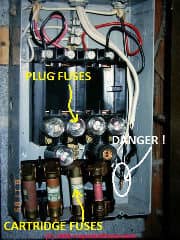 2016/07/31 Benjamin Dowd said:
2016/07/31 Benjamin Dowd said:
I'm buying a house and it looks like this kind of electric box and fuse's I was wondering do I need a new electric panel or with breakers will be safer or is this ok to keep in the house
Reply:
Benjamin
I cannot guess at what is installed in your home and less whether or not it's safe from an e-text; it's just too dangerous to bet the fire and shock safety for you and other occupants on a wild guess.
If you're buying a home and hire a home inspector who is working for you not for the realtor or seller, then she or he is required by virtually all standards, even the most lightweight state licensing code stanards, to inspect the condition of the electrical system: wiring, devices, panel, fusing, etc.
Old electrical panels that use fuses are not innately unsafe and in some cases fuses may be safer than circuit breakers;
but old panels in old houses are very often overloaded and not able to support the number of circuits and total amperage of electrical consumption that most people use in contemporary situations.
That alone will often argue for panel replacement as well as for adding electrical circuits in some areas.
On 2015-04-13 by (mod) - what is in place may not be what would be "approved" by code officials - writer says "hire an electrician"
Anon
Please do not confuse a description of "what is" or what building practices were common with what is recommended or approved by current building officials.
And let's keep nuts and insults out of the discussion.
On 2015-04-09 by Anonymous - old gas pipes used for electrical conduit?
October 18th 2014 --- comment on using old gas pipes as electrical conduit.
Are you NUTS ?? First of all the color of Gas piping is BLACK- this signifies that this is indeed GAS. It has been this way since gas was first brought into homes even OLD homes. Today they also use a YELLOW flexible gas line the color also signifies GAS.
Secondly if this had been inspected the IOR ( Inspector of Record) would have not allowed this wiring method.I have read through some of the other comments listed on this page and you seem to give sound advice in regards to electrical safety to the homeowners that inquire to the issues they face. The best way to deal with any electrical issue is
FIRST turn the POWER OFF,
then call a Certified knowledgeable and qualified electrician.
His services may cost you in the front end,but you will be taking your chances with life safety when you hire your neighbor or HANDYMAN who claims to know how to wire up your pool motor,3 way light switch, A/C unit Etc.
On 2015-01-27 by (mod) - remove clips used in 1950 before romex connectors were made
Anon not sure what "clips" you mean - use our email found at our CONTACT link to send me some photos for comment.
If you refer to the strain relief used on metal boxes sporting BX or armored cable, there are three connecting devices:
2 screws that tighten a sliding clamp against the exterior of the BX cable
1 large nut inside the electrical box that secures the clamp body to the electrical box - removed typially by tapping a screwdriver against the notches in the nut to turn it counter-clockwise - leftie-loosie as my daughter Mara says.
On 2015-01-23 by Anonymous
how do you remove clips used in 1950 before romex connectors were made
On 2014-10-18 by (mod) - Using old abandoned gas piping to run electrical wires is common in older buildings ?
Lea
Using old abandoned gas piping to run electrical wires is common in older buildings.
Watch out: when the ground wire is missing or if the pipe itself is being used as a grounding conductor the installation is improper and unsafe.
And in either case the re-use of existing gas pipes to run electrical wires may not be approved by your local building electrical code compliance inspector. So it'd be smart to check before attempting the work.
On 2014-10-17 by Lea
Hi I had recent electrical work done in old house. Apparently a new wire for light switch has been fed down the old steel pipe. Electrician says this is illegal if it hasn't been earthed! Is this correct and I don't understand then why the electrician hasn't fixed this issue when he saw it.
On 2014-02-23 by (mod) - how do I find out the age of my house?
Marylin we have published a series of articles that help determine the approximate age of a building by looking at its components and features, comparing them when those were first used; Just search InspectApedia for "AGE OF HOUSE"
Or go to AGE of a BUILDING, HOW to DETERMINE - home page
Your local tax department or building authority and registrar of deeds have actual documents on the building.
But I'm not sure why we're barking up this tree of age.
If the wiring is unsafe, improperly installed, or damaged it needs to be repaired by a qualified person; your municipality may or may not permit electrical work to be done by other than a licensed electrician - just ask your building department;
If you feel that the apartment is unsafe you should notify the owners in writing of the conditions you've observed, giving them the opportunity to make an expert assessment. It's surely not in the building owner's interest to permit actual unsafe conditions to persist.
On 2014-02-23 by Marilyn
What if the apartment owner, or management group won't tell me how old the building is (at least 50 years old), or the voltage of my outlets? How do I get this information? Wiring is not done by a certified electrician.
What do I do? I'm at my wits end. I've 8 electrical outlets, with a refrigerator, stove, televisions, stereos, computer, printer, lamps, hair dryer and hair iron, and iron, which are used.
On 2012-10-22 by dustin
i only get 698 a month cant pay some one landlord says my falt my dudy
On 2012-07-18 by (mod) - How much do you charge for an electrical inspection? and what do you do?
Gabriella,
You will want to call a licensed electrician or other qualified building inspector - depending on just what problem you need help with.
We do not sell anything.
InspectAPedia provides building and environmental diagnostic and repair information.
In order to absolutely assure our readers that we write and report without bias we do not sell any products nor do we have any business or financial relationships that could create such conflicts of interest.
InspectAPedia is an independent publisher of building, environmental, and forensic inspection, diagnosis, and repair information for the public - we have no business nor financial connection with any manufacturer or service provider discussed at our website.
We very much welcome critique, questions, or content suggestions for our web articles. Contributors, even if it's just a small correction, are cited, quoted, and linked-to from the appropriate additional web pages and articles - which benefits us both. Working together and exchanging information makes us better informed than any individual can be working alone.
On 2012-07-1 by Gabriella Wofford
How much do you charge for an electrical inspection? and what do you do?
On 2012-05-03 by marc
good article. I have been in the electrical biz for over 30 years. Resi, comm, and Ind. It always amazes me just how much "luck" people have. Bottom line is this: if you don't have any electrical knowledge, or experience, then DON'T even try messing with the electrics in your home, or business !
Electrical wiring is NOT a hobby, even though some of you "weekend warriors" out there "think" it is. Even the most simple thing like replacing a switch, recepticle, or light socket can turn into a disaster.
There are so many ways you can kill yourself, or worse yet, a family member because of wanting to save a few dollars. It always amazes me that most home owners are more concerned with the interior decorating of their homes, but could care less about the various sytems that they take for granted every day!
I have seen it a thousand times! People will spend $10k on a pool installation, but cry about the cost of the electrics involved. I guess you just can't fix stupid.
On 2011-11-28 by (mod) -
Gil Gonzales,
See the article LOST NEUTRAL SHOCKS HOMEOWNER "Case History:Loss of Neutral Shocks Homeowner" using the ground for neutral at a sub panel is improper and risks shock or fire.
On 2011-11-28 by (mod) -
Cindy
Using a volt-ohm meter you can test for voltage to see if the stuff you found is electrical and live.
I'd like to see some sharp photos (use the CONTACT link found at page top, left, or bottom) and I may be able to comment further. Watch out for electric shock hazards.
On 2011-11-19 by Cindyloohoo
Found two pieces of metal coming out of wall beside a door frame upstairs in an older home. It is two pieces of flat metal with round ends and they move up and down in the hole in the wall and it clicks when you do so. I have seen this before but never knew what it was.
On 2011-11-14 by gilgonzalez2000
ground conductor being used as neutral at sub panel
...
Continue reading at OLD HOUSE ELECTRICAL SYSTEMS or select a topic from the closely-related articles below, or see the complete ARTICLE INDEX.
Or see these
Recommended Articles
- ASBESTOS ELECTRICAL WIRE INSULATION
- ELECTRICAL COMPONENTS, AGE, TYPES
- ELECTRICAL GROUNDING in OLDER HOMES
- ELECTRICAL PANEL AGE
- ELECTRIC PANEL AMPACITY
- ELECTRICAL PANEL FUSED NEUTRAL WIRE HAZARDS
- ELECTRIC PANEL WORKING SPACE
- ELECTRICAL RECEPTACLE TYPES
- KNOB & TUBE WIRING
- OLD HOUSE ELECTRICAL SYSTEMS
- ANTIQUE & OLD ELECTRICAL RECEPTACLES
- ANTIQUE LAMPS (BULBS) & CONNECTOR TYPES
- ANTIQUE LAMPS (BULBS) LIGHT OUTPUT - LUMENS
- BULB & LAMP TYPES GUIDE - home
- ELECTRICAL OUTLET, HOW TO ADD in OLDER HOME
- GROUNDING, OLD HOUSE ELECTRICAL
- VOLTAGE AVAILABLE in OLDER HOMES
- AMPACITY AVAILABLE in OLDER HOMES
- KNOB and TUBE WIRING, OLD HOUSE
- NUMBER of CIRCUITS in OLD BUILDINGS
- ELECTRICAL SHORT CIRCUITS
- OLD ELECTRICAL WIRING TYPES
- POLARIZED PLUGS, RECEPTACLES, LIGHTS
- SOLID PIPE EDISON DC CABLE HISTORY
Suggested citation for this web page
OLD HOUSE ELECTRICAL SYSTEM FAQs at InspectApedia.com - online encyclopedia of building & environmental inspection, testing, diagnosis, repair, & problem prevention advice.
Or see this
INDEX to RELATED ARTICLES: ARTICLE INDEX to ELECTRICAL INSPECTION & TESTING
Or use the SEARCH BOX found below to Ask a Question or Search InspectApedia
Ask a Question or Search InspectApedia
Try the search box just below, or if you prefer, post a question or comment in the Comments box below and we will respond promptly.
Search the InspectApedia website
Note: appearance of your Comment below may be delayed: if your comment contains an image, photograph, web link, or text that looks to the software as if it might be a web link, your posting will appear after it has been approved by a moderator. Apologies for the delay.
Only one image can be added per comment but you can post as many comments, and therefore images, as you like.
You will not receive a notification when a response to your question has been posted.
Please bookmark this page to make it easy for you to check back for our response.
Comments
IF above you see "Comment Form is loading comments..." then COMMENT BOX - countable.ca / bawkbox.com IS NOT WORKING.
In any case you are welcome to send an email directly to us at InspectApedia.com at editor@inspectApedia.com
We'll reply to you directly. Please help us help you by noting, in your email, the URL of the InspectApedia page where you wanted to comment.
Citations & References
In addition to any citations in the article above, a full list is available on request.
- Our recommended books about building & mechanical systems design, inspection, problem diagnosis, and repair, and about indoor environment and IAQ testing, diagnosis, and cleanup are at the InspectAPedia Bookstore. Also see our Book Reviews - InspectAPedia.
- In addition to citations & references found in this article, see the research citations given at the end of the related articles found at our suggested
CONTINUE READING or RECOMMENDED ARTICLES.
- Carson, Dunlop & Associates Ltd., 120 Carlton Street Suite 407, Toronto ON M5A 4K2. Tel: (416) 964-9415 1-800-268-7070 Email: info@carsondunlop.com. Alan Carson is a past president of ASHI, the American Society of Home Inspectors.
Thanks to Alan Carson and Bob Dunlop, for permission for InspectAPedia to use text excerpts from The HOME REFERENCE BOOK - the Encyclopedia of Homes and to use illustrations from The ILLUSTRATED HOME .
Carson Dunlop Associates provides extensive home inspection education and report writing material. In gratitude we provide links to tsome Carson Dunlop Associates products and services.


